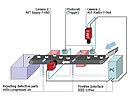
NP Plastics checks the quality of its rollers for document binders with an image-processing system that uses two digital cameras. Graphic courtesy Allied Vision Technologies
Recently, NP Plastics faced a challenge concerning the plastic rollers it makes for the closing mechanism of document binders. Produced by the millions, the 5-millimeter rollers must ensure that the binder is stable when locked but easy to open and close at any time.
The challenge for NP Plastics was to check the quality of many rollers in a short time. More specifically, the manufacturer needed a way to check the geometry of the rollers for defects and sharp edges (or burrs) at a rate of at least 600 parts per minute.
NP chose to check the rollers using an image-processing system custom designed by Radine BV and Data Vision BV. The system features two FireWire digital cameras from Allied Vision Technologies.
Rollers are placed on a moving conveyor belt a minimum of 4 centimeters apart in a random orientation for checking. When a photo cell, located directly over the I/O port, detects the presence of a roller, both cameras are activated.
The first camera, a Marlin F-046B, is vertically mounted over the conveyor belt and measures the rollers’ outer and inner diameters. This camera can shoot up to 53 frames per second, with a minimum shutter time of 11 microseconds, and has an SVGA (super video graphics array) resolution of 0.4 megapixel.
Camera two, a Guppy F-080B, is installed on the side of the conveyor belt and checks the rollers’ outer circumference. This camera can shoot up to 30 frames per second, with a minimum shutter time of 20 microseconds, and has an XGA (extended graphics array) resolution of 0.8 megapixel.
The cameras use an exposure time of less than 85 microseconds to prevent blurring due to motion and capture up to 10 images per second at full resolution. These images instantaneously appear on a computer screen and are evaluated by MVTec Halcon-based software.
The software compares the images of each roller with typical defect patterns stored in a database. When burrs and irregularities are seen on a part, it is automatically pushed off the conveyor with compressed air and collected in a container. This prevents bad parts from ever reaching the next testing station.
“With this system, we can guarantee our most demanding clients that each plastic roller that leaves our factory has had a complete check-up,” says Bas H. Pot of NP Plastics. “We are especially proud of this sophisticated image-processing solution.”
For more information on digital cameras for inspection, call 877-872-1394 or visit www.alliedvisiontec.com.



